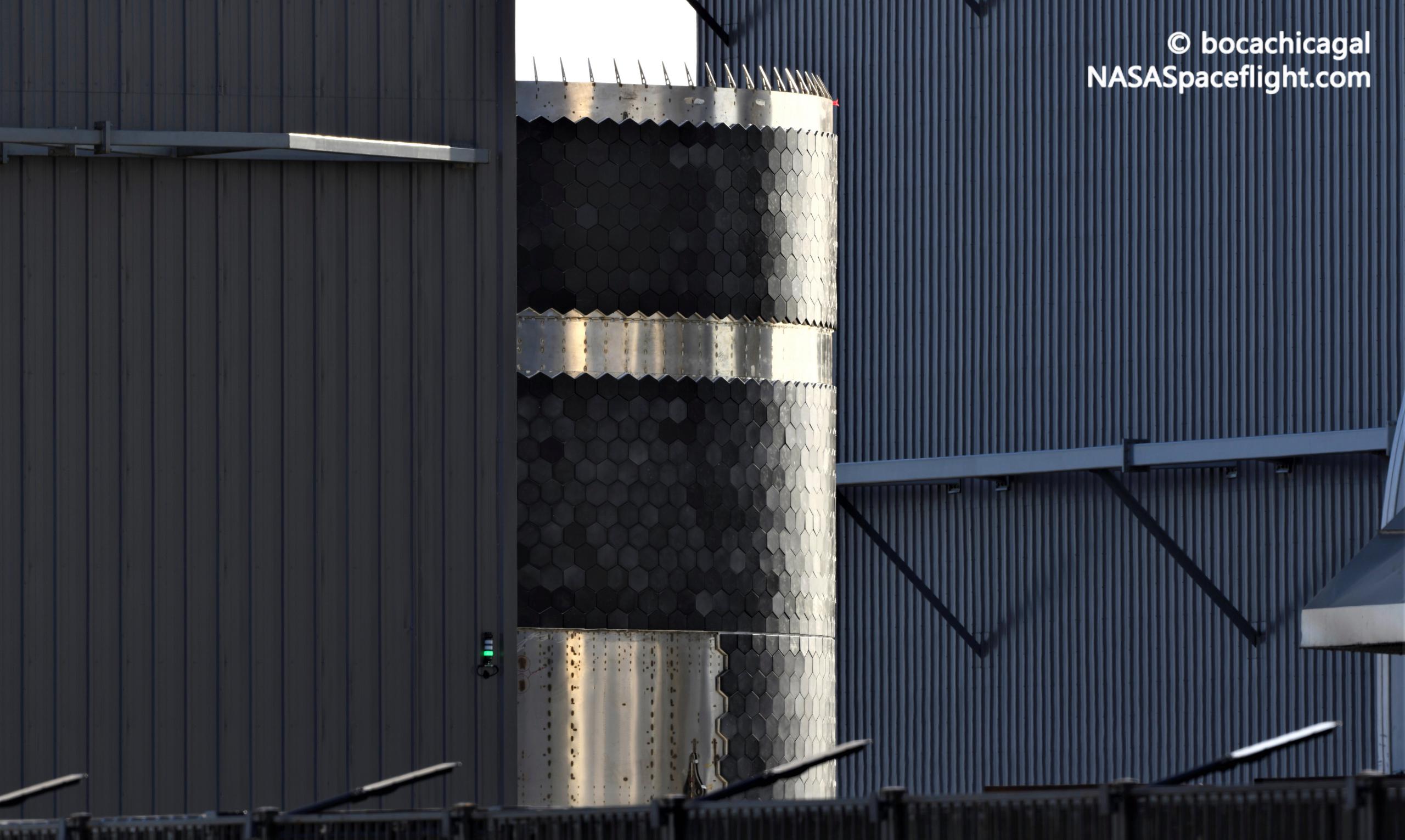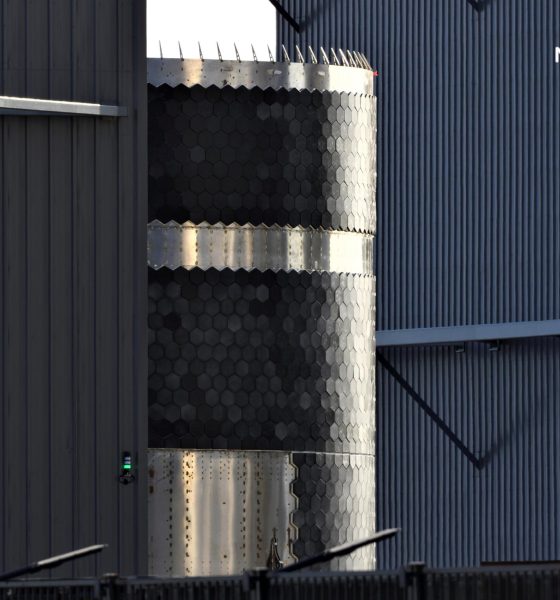At the same time as SpaceX is assembling hardware and manufacturing dozens of Raptor engines for Starship’s inaugural orbital test flight, it’s also preparing for what will follow.
Last week, a local photographer captured photos of one of the many dozens of deliveries that arrive at SpaceX’s Boca Chica Starship factory every month – notable this time around because of package labels that reference a “heat shield” and “mini bakery.” In any other case, it would’ve been just another nondescript delivery – likely carrying the latest batch of the ceramic Starship heat shield tiles SpaceX currently manufactures in Cocoa Beach and Cape Canaveral, Florida.
However, as the photographer (@StarshipGazer) that captured the images noted, that Florida Starship heat shield factory just so happens to be colloquially known as “The Bakery” by the SpaceX team that runs it.
As the nickname would suggest, The Bakery is one of two main Florida-based facilities tasked with turning raw materials into the black, hexagonal heat shield tiles that have begun to spread across the exterior of Starship prototypes. The June 7th delivery of a “mini bakery” strongly implies that SpaceX has now begun to build out some limited capacity for heat shield tile production at Boca Chica itself – under the main Starship factory roof, in other words.
While the number of tiles present has only really begun to grow in the last six or so months, SpaceX has been building, testing, and refining Starship’s heat shield technology for more than two years. SpaceX’s custom-built ceramic tiles made their first public appearances in July and August 2019, first launching into orbit on a Cargo Dragon spacecraft and later tagging along on Starhopper’s spectacular 150m (~500 ft) hop a few weeks later. Dragon went on to reenter and splash down in the Pacific Ocean without issue about a month later, effectively marking the first successful orbital reentry of (part of) a Starship heat shield.
With Starship SN8 heralding the arrival of full-size prototype flight tests in the last few months of 2020, SpaceX began to substantially increase the number of tiles installed on Starships, jumping from a handful to hundreds within a few months. Although Starship SN15’s successful May 5th, 2021 launch and landing likely means it will never fly, Starship SN16 was outfitted with more than a thousand tiles (and SN15 flew with almost as many). While those tiles have essentially zero experience acting as a heat shield on Starship prototypes, launching them on suborbital test flights still subjects those heat shield installations to major thermal and mechanical stresses similar to (or worse than) what Starship will need to withstand during launch and after reentry.
Given that at least a few of the ceramic tiles installed on each prototype have invariably shattered at some point during testing, it’s unclear exactly how successful those coupon tests have been. Unlike the Space Shuttle, which also relied almost exclusively on catastrophically fragile ceramic heat shield tiles, Starship’s tiles are mounted directly to its hull and that hull is made out of steel instead of an aluminum frame. In theory, Starship’s structure can thus withstand – and remain functional – at temperatures approaching 800°C (1500°F), whereas the Shuttle’s heat shield had to keep the vehicle’s aluminum structure below ~180°C (360°F).
Of course, Starship has yet to even attempt to survive an orbital-velocity reentry with some 10,000 ceramic heat shield tiles mounted directly to its steel skin. If successful, SpaceX’s ultra-simple design could give Starship massive advantages over the Shuttle, which ultimately proved to be more dangerous than traditional crew capsules and about as expensive as a similarly capable expendable rocket. But Starship’s heat shield has its work cut out for it to prove that the vast spacecraft is truly up to the challenge of orbital reentry and safe, reliable reuse.

News
Tesla FSD fleet is nearing 7 billion total miles, including 2.5 billion city miles
As can be seen on Tesla’s official FSD webpage, vehicles equipped with the system have now navigated over 6.99 billion miles.

Tesla’s Full Self-Driving (Supervised) fleet is closing in on almost 7 billion total miles driven, as per data posted by the company on its official FSD webpage.
These figures hint at the massive scale of data fueling Tesla’s rapid FSD improvements, which have been quite notable as of late.
FSD mileage milestones
As can be seen on Tesla’s official FSD webpage, vehicles equipped with the system have now navigated over 6.99 billion miles. Tesla owner and avid FSD tester Whole Mars Catalog also shared a screenshot indicating that from the nearly 7 billion miles traveled by the FSD fleet, more than 2.5 billion miles were driven inside cities.
City miles are particularly valuable for complex urban scenarios like unprotected turns, pedestrian interactions, and traffic lights. This is also the difference-maker for FSD, as only complex solutions, such as Waymo’s self-driving taxis, operate similarly on inner-city streets. And even then, incidents such as the San Francisco blackouts have proven challenging for sensor-rich vehicles like Waymos.
Tesla’s data edge
Tesla has a number of advantages in the autonomous vehicle sector, one of which is the size of its fleet and the number of vehicles training FSD on real-world roads. Tesla’s nearly 7 billion FSD miles then allow the company to roll out updates that make its vehicles behave like they are being driven by experienced drivers, even if they are operating on their own.
So notable are Tesla’s improvements to FSD that NVIDIA Director of Robotics Jim Fan, after experiencing FSD v14, noted that the system is the first AI that passes what he described as a “Physical Turing Test.”
“Despite knowing exactly how robot learning works, I still find it magical watching the steering wheel turn by itself. First it feels surreal, next it becomes routine. Then, like the smartphone, taking it away actively hurts. This is how humanity gets rewired and glued to god-like technologies,” Fan wrote in a post on X.
News
Tesla starts showing how FSD will change lives in Europe
Local officials tested the system on narrow country roads and were impressed by FSD’s smooth, human-like driving, with some calling the service a game-changer for everyday life in areas that are far from urban centers.

Tesla has launched Europe’s first public shuttle service using Full Self-Driving (Supervised) in the rural Eifelkreis Bitburg-Prüm region of Germany, demonstrating how the technology can restore independence and mobility for people who struggle with limited transport options.
Local officials tested the system on narrow country roads and were impressed by FSD’s smooth, human-like driving, with some calling the service a game-changer for everyday life in areas that are far from urban centers.
Officials see real impact on rural residents
Arzfeld Mayor Johannes Kuhl and District Administrator Andreas Kruppert personally tested the Tesla shuttle service. This allowed them to see just how well FSD navigated winding lanes and rural roads confidently. Kruppert said, “Autonomous driving sounds like science fiction to many, but we simply see here that it works totally well in rural regions too.” Kuhl, for his part, also noted that FSD “feels like a very experienced driver.”
The pilot complements the area’s “Citizen Bus” program, which provides on-demand rides for elderly residents who can no longer drive themselves. Tesla Europe shared a video of a demonstration of the service, highlighting how FSD gives people their freedom back, even in places where public transport is not as prevalent.
What the Ministry for Economic Affairs and Transport says
Rhineland-Palatinate’s Minister Daniela Schmitt supported the project, praising the collaboration that made this “first of its kind in Europe” possible. As per the ministry, the rural rollout for the service shows FSD’s potential beyond major cities, and it delivers tangible benefits like grocery runs, doctor visits, and social connections for isolated residents.
“Reliable and flexible mobility is especially vital in rural areas. With the launch of a shuttle service using self-driving vehicles (FSD supervised) by Tesla in the Eifelkreis Bitburg-Prüm, an innovative pilot project is now getting underway that complements local community bus services. It is the first project of its kind in Europe.
“The result is a real gain for rural mobility: greater accessibility, more flexibility and tangible benefits for everyday life. A strong signal for innovation, cooperation and future-oriented mobility beyond urban centers,” the ministry wrote in a LinkedIn post.
News
Tesla China quietly posts Robotaxi-related job listing
Tesla China is currently seeking a Low Voltage Electrical Engineer to work on circuit board design for the company’s autonomous vehicles.

Tesla has posted a new job listing in Shanghai explicitly tied to its Robotaxi program, fueling speculation that the company is preparing to launch its dedicated autonomous ride-hailing service in China.
As noted in the listing, Tesla China is currently seeking a Low Voltage Electrical Engineer to work on circuit board design for the company’s autonomous vehicles.
Robotaxi-specific role
The listing, which was shared on social media platform X by industry watcher @tslaming, suggested that Tesla China is looking to fill the role urgently. The job listing itself specifically mentions that the person hired for the role will be working on the Low Voltage Hardware team, which would design the circuit boards that would serve as the nervous system of the Robotaxi.
Key tasks for the role, as indicated in the job listing, include collaboration with PCB layout, firmware, mechanical, program management, and validation teams, among other responsibilities. The role is based in Shanghai.
China Robotaxi launch
China represents a massive potential market for robotaxis, with its dense urban centers and supportive policies in select cities. Tesla has limited permission to roll out FSD in the country, though despite this, its vehicles have been hailed as among the best in the market when it comes to autonomous features. So far, at least, it appears that China supports Tesla’s FSD and Robotaxi rollout.
This was hinted at in November, when Tesla brought the Cybercab to the 8th China International Import Expo (CIIE) in Shanghai, marking the first time that the autonomous two-seater was brought to the Asia-Pacific region. The vehicle, despite not having a release date in China, received a significant amount of interest among the event’s attendees.










